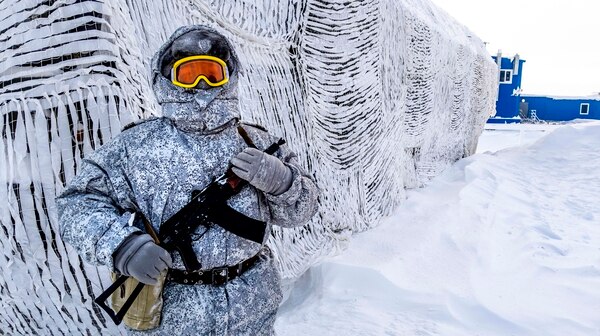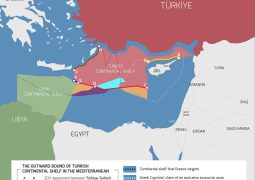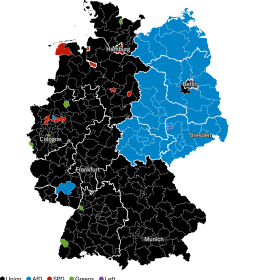US military to challenge Russia with a new Arctic port

Congress wants the US military to challenge Russia with a new Arctic port
Dabid B. Larter
Logistics Specialist 2nd Class Joshua Abney stands low-visibility watch on the forecastle of the destroyer Farragut in the Arctic Circle in 2018. The U.S. Navy is looking to have a more frequent presence in the high north. (MC2 Cameron Stoner/U.S. Navy)
WASHINGTON — The U.S. military’s annual authorization working its way through the Senate directs the armed services and the Maritime Administration to identify and designated a new strategic port in the Arctic, a move meant to counter Russia’s presence at the top of the world.
The 2020 National Defense Authorization Act that emerged from the Senate Armed Services Committee directs the defense secretary to work with the chairman of the Joint Chiefs of Staff, the Army Corps of Engineers, the Coast Guard and the Maritime Administration to submit a report to Congress that evaluates potential sites for the port. It then requires the defense secretary designate one or more of the sites as “Department of Defense Strategic Arctic Ports” within 90 days.
The Senate is expected to vote on the NDAA next week.
A U.S. port in the Arctic would serve as a counter to recent Russian activity in the region, including the construction of its “Northern Clover” military base which features missiles, radars and military personnel.
Congress has been increasingly concerned over melting ice caps opening the potential for new northern trade routes, highlighting the U.S. shortfalls in, among other things, icebreakers. The U.S. has two icebreakers, but only one that barely works while the other serves as a parts locker. Meanwhile Russia has dozens of icebreakers including nuclear-powered ones.
New business opportunities in the Arctic also invite new strategic competition, U.S. defense officials say.
By: Kyle Rempfer
Russia, with 7,000 miles of Arctic coast, sees the region as both a security liability and a key to its long-term economic success. Russian President Vladimir Putin in 2017 riches in
in the region at $30 trillion.
The U.S. Coast Guard gave $750 million contract for detailed design and long-lead materials for a new icebreaker, the first of what the Coast Guard aims to be a small fleet of six icebreakers to meet rising needs in the high north.
Sign up to get The Drift
Sign up for our weekly newsletter to go deeper into all things Navy with David Larter.
Subscribe
Some see an American Arctic base as essential to addressing the melting ice and the potential for new trade routes there, but others see it as a throwback to Cold War-era symmetry policies that don’t take Russia’s vastly different security and economic needs fully into account.
Dan Goure, a former Bush administration defense official and analyst at the Lexington Institute, said that if the U.S. sees Russia as a competitor, as the former claims, then it has no choice but to start offsetting Russian activity in the Arctic. Furthermore, even a modest investment can have big yields, he said.
“They [the Russian government] see the Arctic as a vulnerable long flank — potentially the most vulnerable flank for air and missiles,” Goure said. “The plus side of putting a port up in [the Arctic] is that you don’t have to do a whole hell of a lot to force the Russians to put a lot of resources up there to counter it. The cost of maintaining, say, an airbase in the Arctic is enormous. And those are resources that could be used otherwise to threaten, for example, countries in Europe.”
Warmed-over Cold War?
Bryan Clark, a retired submarine officer and analyst with the Center for Strategic and Budgetary Assessments, said thinking of Arctic bases the way people thought about missiles in the Cold War is unrealistic.
“We [the U.S.] have a coastline on the Arctic, but it’s not exactly the sea route that the northern sea route is,” Clark said, referring to a trade route that runs along Russia’s Arctic coast.
The Russian military base dubbed “Northern Clover” is based on the island of Kotelny, beyond the Arctic Circle. (Maxime Popov/AFP via Getty Images)
“We don’t use the Arctic the same way the Russians do. We don’t have the same exposure as the Russians do. They’ve got 7,000 miles of coastline, it’s difficult to patrol and they’re somewhat neurotic about homeland defense anyway. It’s a perceived vulnerability on the part of Russia and has been for a long time, so they’ve always put a lot of money into the ability to break ice, maintain access.”
For all those reasons, one-for-one comparisons with Russia’s Arctic capabilities are misguided, he said. “Comparing our Arctic capabilities to theirs, it’s kind of off base because you are comparing two very different countries on things that they need in different amounts.”
‘The far end of the logistics chain’
Still, operating in the high north, given the changing conditions, is a good idea, Clark said, and having the military study it is worthwhile.
The problem, however, is when the fleet in the high north needs repair. Coast Guard ships would need to travel to somewhere like Kodiak, Alaska, and the Navy might need to transit back to Puget Sound off the coast of Washington state to get help.
Alternatively, the Navy could set up a forward way station of sorts somewhere like Nome, Alaska, which is along the state’s central-western coastline near the Bering Strait, where the fleet could receive support during months when the area is accessible. But putting something in a place on Alaska’s north slope, like Prudhoe Bay, could be ill-suited because melting permafrost will turn that area into a marshland.
“I think the idea of putting a base up in the far north is a bad idea,” Clark said. “It’s too expensive, and then you’ll build it and not be able to use it for a large part of the year. It becomes a white elephant. What might be a better idea would be to make a waypoint in Nome and use your afloat forward staging base for operations in the far north during the times of year when that is viable.”
The Harry S. Truman Carrier Strike Group operated in the Norwegian Sea during the Trident Juncture exercise in October, and working through logistics challenges was a key takeaway from the drill, Franchetti said.
“Operating at the far end of the logistics chain, it was really important for us to see how we could do that, how it would work, and we took a lot of lessons from that,” she said.
- Previous Dr M: Goldman Sachs offered RM1 billion to settle 1MDB affair
- Next Saudi intelligence chief lobbies London for strikes against Iran: UK source
















